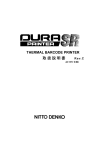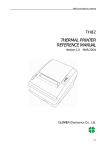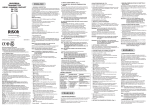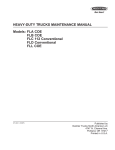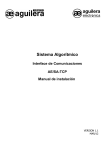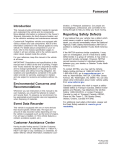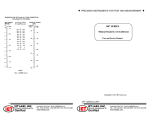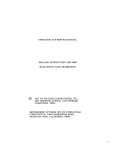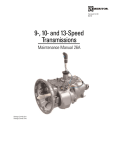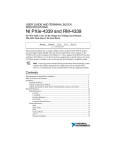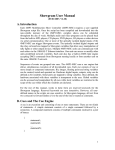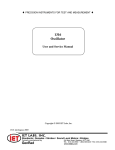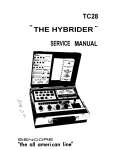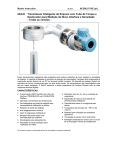Download GR 1864-1644 Megohmmeter Manual
Transcript
♦ PRECISION INSTRUMENTS FOR TEST AND MEASUREMENT ♦ 1864-1644 Positive Polarity Megohmmeter User and Service Manual Copyright © 2014 IET Labs, Inc. Visit www.ietlabs.com for manual revision updates 1864-1644 im/October 2014 IET LABS, INC. www.ietlabs.com Email: [email protected] TEL: (516) 334-5959 • FAX: (516) 334-5988 ♦ PRECISION INSTRUMENTS FOR TEST AND MEASUREMENT ♦ IET LABS, INC. www.ietlabs.com Email: [email protected] TEL: (516) 334-5959 • FAX: (516) 334-5988 WARRANTY We warrant that this product is free from defects in material and workmanship and, when properly used, will perform in accordance with applicable IET specifications. If within one year after original shipment, it is found not to meet this standard, it will be repaired or, at the option of IET, replaced at no charge when returned to IET. Changes in this product not approved by IET or application of voltages or currents greater than those allowed by the specifications shall void this warranty. IET shall not be liable for any indirect, special, or consequential damages, even if notice has been given to the possibility of such damages. THIS WARRANTY IS IN LIEU OF ALL OTHER WARRANTIES, EXPRESSED OR IMPLIED, INCLUDING BUT NOT LIMITED TO, ANY IMPLIED WARRANTY OF MERCHANTABILITY OR FITNESS FOR ANY PARTICULAR PURPOSE. WARNING OBSERVE ALL SAFETY RULES WHEN WORKING WITH HIGH VOLTAGES OR LINE VOLTAGES. Dangerous voltages may be present inside this instrument. Do not open the case Refer servicing to qualified personnel HIGH VOLTAGES MAY BE PRESENT AT THE TERMINALS OF THIS INSTRUMENT WHENEVER HAZARDOUS VOLTAGES (> 45 V) ARE USED, TAKE ALL MEASURES TO AVOID ACCIDENTAL CONTACT WITH ANY LIVE COMPONENTS. USE MAXIMUM INSULATION AND MINIMIZE THE USE OF BARE CONDUCTORS WHEN USING THIS INSTRUMENT. Use extreme caution when working with bare conductors or bus bars. WHEN WORKING WITH HIGH VOLTAGES, POST WARNING SIGNS AND KEEP UNREQUIRED PERSONNEL SAFELY AWAY. CAUTION DO NOT APPLY ANY VOLTAGES OR CURRENTS TO THE TERMINALS OF THIS INSTRUMENT IN EXCESS OF THE MAXIMUM LIMITS INDICATED ON THE FRONT PANEL OR THE OPERATING GUIDE LABEL. 1864-1644 Positive Polarity Megohmmeter Contents Condensed Operating Instructions ..........................................................iv Specifications.............................................................................................v 1864-1644 Specifications ............................................................................................... v Chapter 1: INTRODUCTION .......................................................................1 1.1 Description ............................................................................................................... 1 1.2 Opening and Tilting the Cabinet .............................................................................. 1 1.3 Controls, Connectors and Indicators ........................................................................ 1 1.4 Symbols.................................................................................................................... 5 1.5 Connections.............................................................................................................. 5 Chapter 2: INSTALLATION.........................................................................7 2.1 Initial Inspection ...................................................................................................... 7 2.2 Dimensions .............................................................................................................. 7 2.3 Repackaging for Shipment ....................................................................................... 7 2.4 Storage ..................................................................................................................... 8 2.5 Bench Setup ............................................................................................................. 8 2.6 Rack Mounting......................................................................................................... 8 2.7 Power Connections .................................................................................................. 8 Chapter 3: OPERATION .............................................................................9 3.1 Measurement Setup................................................................................................. 9 3.1.1 Ground-Link Connection ............................................................................... 9 3.1.2 Test Voltage Selection .................................................................................... 9 3.1.4 Connection of Unknown ................................................................................ 9 3.2 Measurement Procedure ................................................................................... 10 3.2.1 General ........................................................................................................... 10 3.2.2 Search Procedure ........................................................................................... 10 3.2.3 Sort Procedure ............................................................................................... 10 3.2.4 Shock Hazard ................................................................................................ 10 3.3 Output Jack .............................................................................................................. 11 Chapter 4: APPLICATIONS ........................................................................13 4.1 Insulation Testing ..................................................................................................... 13 4.2 Test Sample Resistivity Measurements.................................................................... 14 4.3.1 General ........................................................................................................... 14 4.3.2 Charging Time Constant ................................................................................ 14 CONTENTS, FIGURES, AND TABLES i 1864-1644 Positive Polarity Megohmmeter 4.3.3 Measurement Time Constant ......................................................................... 15 4.3.4 Discharge Time .............................................................................................. 15 4.3.5 Large Capacitors, Very High Resistance ....................................................... 15 4.4 Resistance Measurements ........................................................................................ 16 4.5 Measurement of Voltage Coefficient........................................................................ 16 4.6 Guarded 3-Terminal Measurements ......................................................................... 17 4.7 Remote Shielded Measurements .............................................................................. 17 4.8 Measurements Under Humid Conditions................................................................. 17 Chapter 5: THEORY ....................................................................................19 5.1 General .................................................................................................................... 19 5.2 Circuit Description ................................................................................................... 19 5.2.1 General ........................................................................................................... 19 5.2.2 Type 1863 Megohmmeter (Figure 7.6) .......................................................... 19 5.2.3 Type 1864 Megohmmeter (Figure 7.9) .......................................................... 20 Chapter 6: SERVICE AND MAINTENANCE ..............................................21 6.1 Service...................................................................................................................... 21 6.3 Cabinet Removal...................................................................................................... 23 6.4 Troubleshooting ....................................................................................................... 23 6.4.1 General ........................................................................................................... 23 6.4.2 Test Voltages .................................................................................................. 24 6.5 Calibration Procedure .............................................................................................. 24 6.5.1 General ........................................................................................................... 24 6.5.2 Meter Tracking............................................................................................... 24 6.5.3 Voltage Accuracy .................................................................................................. 24 6.5.4 Range-Resistor Accuracy............................................................................... 25 6.5.5 Coarse ∞ Adjustment ..................................................................................... 25 6.6 Knob Removal ......................................................................................................... 26 6.7 Knob Installation...................................................................................................... 27 6.8 Meter Cover Care ..................................................................................................... 27 Chapter 7: PARTS LISTS AND DIAGRAMS ..............................................29 ii CONTENTS, FIGURES, AND TABLES 1864-1644 Positive Polarity Megohmmeter Figures 1864-1644 Front-panel Controls, Connectors and Indicators................................. iv Figure 1-1. Type 1864-1644 Front-panel Controls, Connectors and Indicators ..... 2 Figure 1-2. Type 1864-1644 rear-panel controls and connectors .......................... 4 Figure 1-3. Methods of connection to the measurement terminals ........................ 5 Figure 2-1. Dimensions of the GR/IET 1864-1644 Megohmmeters ...................... 7 Figure 3-1 Ground-link connection to GUARD and to -UNKNOWN terminals ... 9 Figure 4-1. Electrode arrangement for resisitivity measurements ......................... 14 Figure 4.2 Basic megohmmeter circuit ................................................................... 15 Figure 4-3. Guarded measurement of a three-terminal resistor .............................. 16 Figure 5-1 Megohmmeter block diagram ............................................................... 20 Figure 6-1. Connections for measuring standard resistors ..................................... 22 Figure 6-2. Top interior view of 1864 Megohmmeter ........................................... 26 Figure 6-3. Bottom interior view of 1864 Megohmmeter ...................................... 26 Figure 7-1. Replaceable mechanical parts on the 1864-1644 ................................. 31 Figure 7-3. Type 1864 rectifier circuit etched-board assembly .............................. 32 Figure 7-2. Regulator and amplifier circuits etched-board assembly ..................... 32 Figure 7-4 Type 1864 switching diagram ............................................................... 33 Figure 7-5. Type 1864 schematic diagram.............................................................. 34 Figure 7-6. Complete cabinet assembly.................................................................. 35 CONTENTS, FIGURES, AND TABLES iii 1864-1644 Positive Polarity Megohmmeter Condensed Operating Instructions SET ∞ HIGHEST RANGE GROUND SET ∞ GUARD - UNKNOWN + MULTIPLIER DIAL FUNCTION SWITCH POWER-OFF SWITCH TEST-VOLTAGE SWITCHES 1864-1644 Front-panel Controls, Connectors and Indicators 1. Determine which ground link connection is to be used (paragraph 3.1.1 ). 4. Connect the unknown to the UNKNOWN terminals. 2. Set the TEST VOLTAGE switch(es) to the proper voltage (paragraph 3.1.2). 5. Measure the unknown with either the search (paragraph 3.2.2) or sort (paragraph 3.2.3) procedure. 3. Set the ∞ adjustments (paragraph 3.1.3). iv CONTENTS, FIGURES, AND TABLES 1864-1644 Positive Polarity Megohmmeter Specifications 1864-1644 Specifications Rmin Rmax (right end) Useful (Full Scale left end) (10% of scale) (2.5% of scale) Ranges ("0.5" rdg) ("5" rdg) ("20" rdg) Voltage Setting 10 Vdc to 50 Vdc 50 kΩ 500 GΩ 2 TΩ* 50 Vdc to 100 Vdc 200 kΩ 5 TΩ 20 TΩ 7 8 100 Vdc to 500 Vdc 500 kΩ 5 TΩ 20 TΩ* 7 500 Vdc to 1090 Vdc 5 MΩ 50 TΩ 200 TΩ 8 *Recommended Limit Resistance Accuracy (min reading 0.5): Range 1-5: ±2 (meter reading+1)% Where meter reading is the actual number indicated at the scale; e.g. for a reading of 900 kΩ on the 1 GΩ scale, the accuracy is ±2(.9+1)% or 3.8% Range 6: Range 7: Range 8: add ±2% to accuracy above add ±3% to accuracy above add ±5% to accuracy above Accuracy applies for >100 V; For ≤100 V add 2%. Meter Display: Full mechanical zero at right end, so 2.5 % fullscale is near right end and full-scale is at left end. However, resistance values read naturally, increasing from left to right. Short-Circuit Current: Approximately 5 mA Power: 100 - 125 or 200 - 250 V 50 - 400 Hz 13 W Fuse: For 100 to 125 V operation: 1/4 A For 200 to 250 V operation: 1/8 A Fuse holder is located under the IEC receptacle and holds a 5 x 20 mm fuse. Dimensions: 6.63 x 10 x 6.75 in. Weight: 9.5 lb. Voltage Accuracy (across unknown): For ≥100 V ± 2% For <100 V ± (4% + 0.5 V) CONTENTS, FIGURES, AND TABLES v 1864-1644 Positive Polarity Megohmmeter This page intentionally left blank. vi CONTENTS, FIGURES, AND TABLES 1864-1644 Positive Polarity Megohmmeter Chapter 1 INTRODUCTION WARNING High voltage is applied to the measurement terminals of 1864-1644 Megohmmeters at all times, except when the function switch is set to DISCHARGE. While the current is limited to a value that is not dangerous under most conditions, the energy stored in a capacitor connected to the terminals may be LETHAL. Always set the function switch to DISCHARGE before you connect or disconnect the unknown. 1.1 Description 1.2 Opening and Tilting the Cabinet The 1864-1644 (Figure 1-1) indicates resistance from 50 kΩ to 200 TΩ. These ranges are suitable for leakage-resistance measurements of most types of insulation used in electrical instruments, electronic devices and components, etc (Section 4). The 1864 has a voltage range from 10 to 1090 V that can be set in 1 Vdc steps from 10 to 109 V, and in 10 V steps from 100 to 1090 V by using the TEST VOLTAGE switches on the front panel. To open the cabinet, refer to the pictorial graphic on the rear panel of the unit; see Figure 1-2. The Flip-Tilt cabinet can be opened by placing the instrument on its rubber feet with the handle away from you. Push down on the handle and the instrument, located in the upper part of the case, will rotate to a vertical position. While holding the handle down with one hand, rotate the instrument to the desired position with the other hand and then slowly release the handle. The 100-volt setting is the EIA standard for measurement of composition, film, and wire-wound resistors above 100 kilohms. The 500-volt setting is a standard value in the measurement of the insulation resistance of rotating machinery, transformers, cables, capacitors, appliances, and other electrical equipment. A regulated power supply and charging circuit permit rapid and accurate measurement of the leakage resistance of capacitors. 1.3 Controls, Connectors and Indicators Figure 1-1 shows the front-panel controls, connectors and indicators of the 1864. Table 1-1 lists and identifies them. Figure 1-2 shows the rear panel controls and connectors, and Table 1-2 lists and identifies them. Guard and ground terminals permit measurement of grounded or ungrounded two-or three-terminal resistors. A panel warning light indicates when voltage is applied to the test terminals and alerts users to the safe operation of the instrument. INTRODUCTION 1 1864-1644 Positive Polarity Megohmmeter 3 4 6 5 7 8 2 9 10 1 11 12 Figure 1-1. Type 1864-1644 Front-panel Controls, Connectors and Indicators 2 INTRODUCTION 1864-1644 Positive Polarity Megohmmeter Figure 1.1 Reference Name Type Function 1 POWER OFF 2-position toggle switch Turn power on and off. 2 Meter 4-in. meter with plastic cover Indicates the value to be multiplies by the multiplier switch. 3 SET ∞ HIGHEST RANGE Knob-rotated control Adjusts high end of meter scale on highest resistance range to compensate for offset current. 4 SET ∞ Knob-rotated control Adjusts high end of meter scale on highest resistance range to compensate for offset voltage in the voltmeter. 5 GUARD Insulated binding post For guarded measurements. It can accept a shorting link to the ground post. 6 Ground Uninsulated binding post Grounds the Unknown- or guard. Contains a shorting link. 7 UNKNOWN - Insulated binding post Connects the - side of the unknown to the megohmmeter. 8 UNKNOWN + Insulated binding post Connects the + side of the unknown to the megohmmeter. 9 DANGER Indicated light shaded red Glows red when the function switch is in the CHARGE or MEASURE position. 10 Multiplier 8-position rotary switch Selects resistance range. 11 MEASURE CHARGE DISCHARGE 3-position toggle switch Selects the operating position applied to the unknown. 3 rotary switches: 12 TEST VOLTAGE Select voltage in 1-V steps from 10 to 109 V and in 100-V steps from 100 to 1090 V. INTRODUCTION 10-position 9-position 2-position 3 1864-1644 Positive Polarity Megohmmeter 1 3 2 4 Figure 1-2. Type 1864-1644 rear-panel controls and connectors Table 1.2. Figure 1-2 Reference 1 4 Name Type Function Power Input IEC Standard Power input receptacle. Power input and circuit protection 2 Output Phone jack Provides a dc voltage output for recorder operation 3 Line Voltage 2-position slide switch Connects wiring of power transformer for either 100 to 125 V or 200 to 250 V input 4 1/8 Amp Integral fuse holder Holder for 5 x 20 mm For 100 to 125 V operation: 1/4 A fuse For 200 to 250 V operation: 1/8 A fuse INTRODUCTION 1864-1644 Positive Polarity Megohmmeter 1.4 Symbols 1.5 Connections These instruments indicate the resistance of the unknown in multiples of ohms. The relationship between ohms (Ω), kilohms (kΩ), megohms (MΩ), gigaohms (GΩ), and teraohms (TΩ) is as follows: The UNKNOWN, GUARD and ground terminals are standard 3/4-in. spaced binding posts that accept banana plugs, standard telephone tips, alligator clips, crocodile clips, spade terminals and all wire sizes up to number eleven (Figure 1-3). 1 MΩ= 106 Ω = 103 kΩ I GΩ= 109 Ω = 106 kΩ= 103 MΩ 1 TΩ = 1012 Ω = 109 kΩ = 106 MΩ= 103GΩ When several measurements of components with leads are to be made, consult IET for an appropriate test jig or fixture. Figure 1-3. Methods of connection to the measurement terminals INTRODUCTION 5 1864-1644 Positive Polarity Megohmmeter This page intentionally left blank. 6 INTRODUCTION 1864-1644 Positive Polarity Megohmmeter Chapter 2 INSTALLATION Dimensions in inches Figure 2-1. Dimensions of the GR/IET 1864-1644 Megohmmeters 2.1 Initial Inspection 2.3 Repackaging for Shipment IET instruments receive a careful mechanical and electrical inspection before shipment. Upon receipt, verify that the contents are intact and as ordered. The instrument should then be given a visual and operational inspection. If the instrument is to be returned to IET Labs, contact the Service Department at the number or address, shown on the front cover of this manual, to obtain a “Returned Material Authorization” (RMA) number and any special shipping instructions or assistance. Proceed as follows: If any shipping damage is found, contact the carrier and IET Labs. If any operational problems are encountered, contact IET Labs and refer to the warranty at the beginning of this manual. Save all original packing material for convenience in case shipping of the instrument should become necessary. 1. 2. 3. 4. 2.2 Dimensions 5. The dimensions of the 1864-1644 are shown in both the rack and bench-mounted configurations in Figure 2-1. INSTALLATION 6. 7. Attach a tag with the following: • Owner’s Name • Model Number • Serial Number • RMA Number Wrap the instrument in heavy paper or plastic. Protect the front panel and any other protrusions with cardboard or foam padding. Place instrument in original container or equally substantial heavy carton. Use packing material around all sides of instrument. Seal with strong tape or bands. Mark shipping container “DELICATE INSTRUMENT,” “FRAGILE,” etc. 7 1864-1644 Positive Polarity Megohmmeter 2.4 Storage 2.7 Power Connections If this instrument is to be stored for any lengthy period of time, it should be sealed in plastic and stored in a dry location. It should not be subjected to temperature extremes beyond the specifications. Extended exposure to such temperatures can result in an irreversible change in resistance, and require recalibration. The 1864-1644 Megohmmeter can be operated from either a 100- to 125-V or a 200- to 250-V, 50-to 60Hz power line. Before connecting the 3-wire IEC power cord to the line, set the slide switch on the rear panel to the proper setting as indicated by the position of the white line on the slide switch. The slide can be actuated with a screwdriver blade. Verify that the correct size fuse for the input voltage selected has been installed (1/4 A slow blow for 100-125 V input or 1/8 A slow blow for 200-250 V input). If it is necessary to use a 3-wire adaptor plug, make certain that the third wire is connected to a good ground (water pipe or equivalent). If this is not possible, connect the panel of the 1864-1644 (uninsulated binding post) to a good ground. Plug the supplied IEC power cord into the instrument into a power receptacle. The power cord may of course be selected to match the available receptacle. 2.5 Bench Setup The bench (portable) model of the megohmmeter is cased in a Flip-Tilt cabinet. The cabinet opens by pushing down on the handle and tipping the instrument into the desired operating position (paragraph 1.2). 2.6 Rack Mounting Consult IET Labs. 8 INSTALLATION 1864-1644 Positive Polarity Megohmmeter Chapter 3 OPERATION 3.1.3 Set ∞ Adjustments 3.1 Measurement Setup 3.1.1 Ground-Link Connection The grounding link connected to the uninsulated, grounded, binding post can be connected from this ground terminal to the GUARD (paragraph 4.6) or the -UNKNOWN terminal (Figure 31). The ground link should be connected to the GUARD terminal if the sample to be measured is a small, separate component, or if it is a component mounted in an enclosure that should be guarded (see paragraph 4.6). However, if one terminal of the unknown must be grounded, then the link should tie the -UNKNOWN terminal to the instrument case. See Figure 3.1. - + To adjust the SET ∞ controls, proceed as follows: 1. Turn the instrument on. 2. Set the function switch to DISCHARGE. 3. Set the multiplier dial to any range. 4. Make certain that there nothing is connected to the UNKNOWN terminals. 5. Adjust the SET ∞ control for an ∞ reading on the meter. 6. Set the multiplier switch to 10-1T 7. Set the function switch to MEASURE. 8. Adjust the SET ∞ HIGHEST RANGE for an ∞ meter reading. If this adjustment cannot be made electrically, turn the instrument off, and adjust the mechanical meter zero adjustment (the center screw on the meter) to give a meter reading of less than a line width beyond ∞. Repeat steps 1 through 7. 3.1.4 Connection of Unknown - + Small components should be connected directly to the UNKNOWN terminals. Insulated leads can be connected to a nearby unknown; however, if the unknown resistance is high, leakage between the leads will cause a measurement error, and a change in capacitance to the high lead will cause a transient meter deflection. For such high resistance measurements, a shielded system is preferable (refer to paragraph 4.7). Figure 3-1 Ground-link connection to GUARD terminal (top) and to -UNKNOWN terminal (bottom) 3.1.2 Test Voltage Selection The TEST VOLTAGE switch(es) should be set to the desired measurement voltage. The 1864-1644 Megohmmeter has a selection of 10 to 109 Vdc in 1-V steps or 100 to 1090 Vdc in 10-V steps. On the 1864, the right-hand TEST VOLTAGE switch must be set to the V position for the low voltages and to the 0 V position for the high voltages. OPERATION 9 1864-1644 Positive Polarity Megohmmeter 3.2 Measurement Procedure 3.2.1 General Either of two measurement procedures may be used, depending on whether or not the correct resistancemultiplier range is known. If the range is not known, the search procedure (paragraph 3.2.2) should be followed. If repetitive measurements are to be made on a given range (i.e., if similar components are to be sorted) the sort procedure (paragraph 3.2.3) should be used. 3.2.2 Search Procedure When the approximate resistance of the sample to be measured is not known, proceed as follows: 1. 2. 3. 4. 5. 6. 7. Set the multiplier switch to the lowest range. Set the function switch to DISCHARGE. Connect the unknown between the UNKNOWN + and - terminals. Set the function switch to MEASURE. Rotate the multiplier switch cw until the meter gives a reading of less than 5. The resistance of the unknown is the meter reading multiplied by the multiplier-switch indication. Make measurements towards the low end of the meter scale whenever possible, for best accuracy and resolution. 3.2.3 Sort Procedure When the approximate resistance of the unknown is known, proceed as follows: 1. 2. 3. 4. 5. 6. Set the function switch to DISCHARGE. Set the multiplier switch to the desired range. Connect the unknown between the UNKNOWN + and - terminals. Set the function switch to MEASURE. The resistance of the unknown is the meter reading multiplied by the multiplier-switch indication. For go-no-go checks, it can be useful to make high-and-low limit lines on the outside of the meter case with strips of masking tape. Make measurements towards the low end of the meter scale whenever possible, for best accuracy and resolution. 3.2.4 Shock Hazard Every precaution has been taken in the design of 1864 Megohmmeters to reduce the possibility of shock. However, high voltage must be present at the terminals to make measurements at the required voltage levels, and the operator should be aware of the dangers involved. The current delivered by the megohmmeters under short-circuit conditions is approximately 5 mA. This 5-mA current is not lethal to most persons but might be lethal to those with poor hearts, and it is painful to all. The actual current that will flow through a person depends on the resistance of the part of the body that makes contact with the terminals. This resistance can be as low as 300 Ω. Note that any of the three insulated binding posts can be at high voltage, depending on the position of the shorting link. When capacitors are tested there is an especially dangerous condition because a charged capacitor easily can have enough energy to cause heart fibrillation and death. The capacitor should always be shunted before connection to the megohmmeter, and the function switch should be set to DISCHARGE for a few seconds before the capacitor is disconnected. We strongly recommend that additional precautions, such as rubber gloves and insulated benchtops, chairs and shoes should be used for anyone making repetitive measurements with the megohmmeter, particularly measurements on capacitors. These precautions should not take the place of careful discharge of the capacitors before and after measurement, but should be used as an additional safety measure. 10 OPERATION 1864-1644 Positive Polarity Megohmmeter 3.3 Output Jack The OUTPUT jack (J105) on the rear panel makes accessible a dc voltage that is directly proportional to the reciprocal of the meter reading, that is, the highest value is at the 0.5 scale reading and the lowest value is at ∞. The output voltage for a particular multiplierswitch setting can be calculated by RRANGE VOUT = 0.02 x VTEST x RX where VTEST is the TEST VOLTAGE setting, RRANGE is the lower value for a particular multiplier-dial setting (100k for the 1 M/100 k range) and Rx is the value of the resistance being measured. The output can be stored in a data file for plotting, display, or analysis. It can also feed the user’s go/ no-go indicator. The full-scale voltage value for any test voltage can be calculated from the Vout formula using 0.5 times the measurement range as the Rx value. These values are available on the 1864 along with the other levels that can be set with the variable TEST VOLTAGE switches (see table 3-1). OPERATION 11 1864-1644 Positive Polarity Megohmmeter This page intentionally left blank. 12 OPERATION 1864-1644 Positive Polarity Megohmmeter Chapter 4 APPLICATIONS 4.1 Insulation Testing The insulation resistance of electrical machinery, transducers, etc, is one of several parameters that may indicate the condition of the insulation. Routine measurement of capacitance, dissipation factor, and leakage resistance provides useful data for monitoring the condition of the insulation and for guarding against incipient breakdown. A routine test that has been widely adopted for insulation testing calls for the measurement of the apparent leakage resistance after a test voltage has been applied for one minute and again after the test voltage has been applied for 10 minutes. The ratio of the indicated resistances, sometimes referred to as the Polarization Index, can have some relation to the condition of the Insulation. The results of such a measurement are apt to be more dependent on the dielectric absorption of the insulator than on its true leakage resistance measured at equilibrium. A complete charge-current-vs-time plot will provide more useful information. 2G The 1864-1644 Megohmmeters can be used for either true leakage measurements or for measurements at 1-or 10-minute intervals following the operating procedure described in Section 3. MIL-STD-202C gives procedures for insulationresistance measurements of various components. On large machinery, one terminal must usually be grounded. The 1864-1644 Megohmmeter is designed so that the binding post grounding strap should be connected between the ground terminal and the -UNKNOWN terminal. To determine the charge current, divide the test voltage by the indicated resistance. At the start of a charge-current-vs-time plot, the meter will be off scale. The resistance in series with the insulator is the reading of the upper dial multiplier divided by 500. Table 4-1 lists dial readings and resistor values. APPLICATIONS 13 1864-1644 Positive Polarity Megohmmeter WARNING Capacitors being measured may be charged and may contain lethal energy. Always set the function switch to DISCHARGE before connecting or disconnecting the capacitor under test. 4.3.2 Charging Time Constant Figure 4-1. Electrode arrangement for resisitivity measurements The time constant for charging a capacitor in the CHARGE position is determined by the value of the capacitor times the effective source impedance of the supply. The supply resistance is approximately, 4.2 Test Sample Resistivity Measurements The megohmmeter can be used for measuring the resistivity of test samples as described by ASTM Standard D257, which describes in detail the techniques for both surface-and volume-resistivity measurements. The most common electrode arrangement is that shown in Figure 4.1. In this configuration surface resistivity is measured with terminal 1 tied to the -UNKNOWN terminal, terminal 2 tied to the +UNKNOWN terminal and terminal 3 tied to GUARD. For volume resistivity measurements, terminal 1 is tied to the -UNKNOWN terminal, terminal 2 to the GUARD and terminal 3 to the +UNKNOWN terminal. The formulas required to convert from measured resistance to resistivity are given in the ASTM standard. Contact IET regarding the availability of resistivity test fixtures. 4.3 Capacitor Insulation Resistance 4.3.1 General The insulation resistance, IR, of capacitors is measured by either the search or sort method (paragraph 3.2.2 and 3.2.3) used for resistors, except that some consideration must be given to the charge and discharge currents. 14 E E E R0 = I Ω = 0.005A Ω = 5 kΩ MAX where E is the indicated test voltage in volts and IMAX is the short-circuit current, which is approximately 5 mA. Therefore, the time constant is: T = R0Cx = ECX 5000 seconds where Cx is in μF. As an example, on the 500 V range, R0 is approximately 100 kΩ so that the time constant for charging of a 1 μF capacitor is 0.1 s. The time necessary for full charging depends on the type of capacitor and the leakage current that is to be measured. A capacitor with no dielectric absorption will have a charging current that decreases by a factor of 2.72 (the natural logarithm to the base e) for every time constant it is left in the CHARGE position. Thus,t the effective resistance at any moment is R0E( R C ) . The capacitor could be considered fully charged when this resistance is substantially higher than the true leakage resistance, even though the charging current theoretically never reaches zero. As an example a 1 μF capacitor, with a leakage resistance of 1010Ω measured at 500 V, would have less than 1% error due to charging current, if measured after seventeen time constants, or 1.7 s. 0 X APPLICATIONS 1864-1644 Positive Polarity Megohmmeter Dielectric absorption (dipole and interfacial polarization) is present in many capacitors and insulators, especially those with a laminated structure. When voltage is applied to such material, the charge slowly diffuses throughout the volume and several minutes, hours, or even days, are required for equilibrium in order to make the charging current small compared with the true leakage current. A measure of this effect, called the Polarization Index, is the ratio of the resistance measured after 10 minutes of charging to that measured after 1 minute of charging. Often, the measured resistance after 1 minute of charging is called the insulation resistance, even though charging current may be much larger than the true leakage current. (Some capacitor specifications say less than 2 minutes). 4.3.3 Measurement Time Constant When the function switch is set from the CHARGE position to the MEASURE position, the standard resistor is placed in series with the unknown capacitor. If the supply voltage is fixed, the capacitor must discharge by a voltage equal to that across the voltmeter at its final reading. The time constant for this discharge would be CXRs. Because 80% of the output voltage is fed back to the supply, this time constant is reduced by a factor of 5. As a result, the time necessary for an indication, assuming an ideal capacitor, depends on this time constant or that of the meter movement, whichever is longer. 4.3.4 Discharge Time With the function switch set at DISCHARGE, the UNKNOWN terminals are connected through 470 Ω and the discharge time is approximately 0.0005 x C μs, where C is in μF. The red DANGER light is turned off by the function switch, so that the capacitor might be charged even after the light is extinguished. However, the discharge time is so short that this is not a practical consideration, except for capacitors greater than 100 μF. Capacitors with high dielectric absorption (paragraph 4.3.2) can have a residual charge even after they are shunted and must be repeatedly shunted to be completely discharged. Usually this "voltage recovery" is only a few percent (i.e., 3%) of the original applied voltage and, therefore, not dangerous to the operator, but it can cause damage to sensitive circuit elements. 4.3.5 Large Capacitors, Very High Resistance Measuring insulation resistance of large capacitors that have very low leakage is difficult by any method. Considering the basic circuit of Figure 4.2, if RS is high, the RS CX time constant can become very long on the high resistance ranges if CX is large. If RS is low, the voltmeter must be very sensitive for a given leakage resistance range and, therefore, the supply voltage (E) must be extremely stable to avoid large meter fluctuations. The design of the 1864 is a compromise between these factors. Measurements become difficult when the RSCX product is 106, even under ideal conditions. This can be calculated as (CX in μF) x (RS in MΩ) or (CX in F) x (RS in Ω). Table 4.1 contains values for RS Measurements can be unsatisfactory even below this value for an RSCX product for several reasons: Figure 4.2 Basic megohmmeter circuit APPLICATIONS 15 1864-1644 Positive Polarity Megohmmeter 1. Dielectric absorbtion. (paragraph 4.3.2). This is the main cause of erroneous readings. Besides the difficulty in deciding what charging period should be used, the previous history of the capacitor will greatly affect its indicated leakage. For example, if a paper capacitor is charged to its rated value, discharged for a short time, and then its leakage current is measured at some low value, it probably will give a reading beyond ∞. This is due to voltage recovery that is a consequence of dielectric absorbtion. The voltage across the capacitor will increase above the test voltage causing current to flow in the reverse direction. 4.5 Measurement of Voltage Coefficient 2. Temperature coefficient. If the temperature on the unknown changes and it has an appreciable temperature coefficient, the voltage on the capacitor will change in the MEASURE position. If RS is large, the charge (Q) of the capacitor is more-or-less constant, so if its capacitance changes, its voltage must change (Q=CV). A temperature-controlled environment is recommended. For example, if V1 = 500 V and V2 = 100 V 3. Test voltage changes. The test voltage can have rapid fluctuations due to large line-voltage transients even though good regulation is provided in the instrument, because when RSCX is large, the test voltage fluctuations are transmitted to the voltmeter unattenuated. This difficulty can be reduced if the line voltage is regulated. Slow drift of the test voltage can cause erroneous readings if RSCX. is large, because even a slow drift rate can be fast compared to the RSCX time constant. A decreasing test voltage can cause a reading beyond. Sufficient warm-up time (30 minutes) will allow the temperature inside the megohmmeter to stabilize and result in a more constant voltage at the UNKNOWN terminals. The 1864 Megohmmeter may be used to measure voltage coefficient as long as its accuracy is adequate. The voltage coefficient of resistance is defined as: R1-R2 R2(V1-V2) x 100% where V1 > V2 R1 is the resistance at V1, the higher voltage R2 is the resistance at V2 Voltage coefficient = R500V-R100V x (400)R100V 1 100% ΔR % = 4 R100V This voltage coefficient is usually negative (except for reversed semiconductor junctions). - 4.4 Resistance Measurements + The recommended test voltage is 100 V for fixed composition resistors, film resistors, and wire-wound resistors above 100 kΩ. (Refer to EIA Standards RS172, RS196, and REC 229.) These resistors can be measured easily on the megohmmeter as long as the accuracy of the instrument is adequate. If the resistors are separate, we suggest that they be measured ungrounded (with the grounding link connected to the GUARD terminal). 16 Figure 4-3. Guarded measurement of a three-terminal resistor APPLICATIONS 1864-1644 Positive Polarity Megohmmeter 4.6 Guarded 3-Terminal Measurements In many cases it is necessary to measure the resistance between two points in the presence of resistance from each of these points to a third point. This third point can often be guarded to avoid error caused by the extraneous resistances. This situation can be shown diagrammatically as a three-terminal resistor (Figure 4-3). Here, RX is the quantity to be measured in the presence of RA and RB. If the junction of RA and RB is tied to a guard, RA is placed across the power supply and has no effect if it is greater than 500 kΩ. RB shunts RS and causes a much smaller error than that which would be present if no guard were used. The error is approximately -RS/RB x 100%, where RS equals the value shown in Table 4-1 for the various ranges. If a choice is possible, the higher of the two stray resistances should be connected as RB. The guard terminal can be used whether the GUARD or the - UNKNOWN terminal is grounded, but note that if the -UNKNOWN terminal is grounded, the GUARD terminal will be a high positive voltage level. Often the terminal to be guarded is a large chassis and it is, therefore, safer to ground the GUARD terminal. If this third terminal is true ground then the GUARD terminal must be grounded. 4.8 Measurements Under Humid Conditions The 1864 Megohmmeter has been designed to operate under conditions of high humidity but, nevertheless, a few simple precautions should be taken to ensure accurate measurements. These precautions are: 1. Allow several minutes warmup (internal heat will reduce humidity inside the instrument). 2. Clean the binding-post insulation with a dry, clean cloth. 3. Use ungrounded operation (tie the GUARD terminal to the panel ground). To determine the presence of errors due to humidity, measure the resistance between the binding posts with no external connections. Note that with the -UNKNOWN terminal grounded, breathing on the terminals will cause a meter deflection because leakage from the insulator of the +UNKNOWN terminal to the panel is measured. Actually, this problem is somewhat academic because the unknown to be measured is usually much more severely affected by humidity than is the megohmmeter. 4.7 Remote Shielded Measurements Measurements can be made on components that are some distance from the instrument if care is used to prevent leakage between the connecting leads and to avoid the shock hazard. A convenient way to do this is to use a shielded cable. If the unknown can be measured ungrounded, make the connection to the +UNKNOWN terminal with the shielded lead, tie the shield to the GUARD terminal, and connect the GUARD terminal to the panel ground with the connecting link. If one side of the unknown must be grounded, connect the grounding link to the +UNKNOWN terminal, shield the +UNKNOWN terminal, and tie the shield to the GUARD terminal. In this instance, the shield is not at ground potential and should be insulated. APPLICATIONS 17 1864-1644 Positive Polarity Megohmmeter This page intentionally left blank. 18 APPLICATIONS 1864-1644 Positive Polarity Megohmmeter Chapter 5 THEORY 5.1 General The 1864 Megohmmeter basically consists of a regulated dc power supply, a set of precision resistors, and a FET-input voltmeter (Figure 5.1). Switch S1 is closed in the DISCHARGE position of the function switch and open in the CHARGE and MEASURE positions, while S2 is open only in the MEASURE position. The regulated voltage, E, is controlled by a resistance RA. A meter sensitivity resistor, RB , is ganged to the voltage control resistor, RA, to make the meter reading independent of applied voltage, (assuming that the unknown has no voltage coefficient). An inverse scale is used on a reversed meter to give a reading proportional to RX (and not its reciprocal) and yet have a scale that increases from left to right (0 to ∞). Metal-film standard resistors are used on all ranges. The top range of each instrument uses feedback to effectively multiply the value of the previous standard resistor by a factor of ten. In the 1864 the 2 GΩ resistor is multiplied to 20 GΩ. The specifications are again broadened to allow for the tolerance variations of this multiplication. The voltmeter uses a FET-input, four-stage, unity-gain amplifier (AMP, Figure 5.2) to obtain high stability and low drift. The SET ∞ control on both instruments is a voltage balance control, while the SET ∞ HIGHEST RANGE control compensates for the FET gate current on the highest ranges. 5.2 Circuit Description 5.2.2 Type 1863 Megohmmeter (Figure 7.6) The voltage supply section (RECT.) of the 1863 consists of five different circuits, three dc and two ac. One ac circuit is a voltage source for the three pilot lamps used, two to indicate the measurement range (P101, P102) and the third to light the DANGER indicator (P103). The second supplies filament voltage to the vacuum tube V101. The first dc supply is a half-wave rectifier circuit with a 24-V Zener diode (CR 111) that supplies voltages to the amplifier (AMP) circuit. A second dc supply is a voltage doubler (CR101-CR104, C101C102) that supplies the plate voltage to V101. The voltage to the plate is the same for the 50- to 250-V ranges but R109 is eliminated from the circuit for the 500 V range. The third dc supply is a half-wave rectifier with a 20-V Zener diode (CR211) to supply voltage levels to run the unity-gain amplifier (+1). Tube V101 is a series regulator that is controlled by the 5.6 V Zener diode (CR112, REF) and the setting of R140.The voltage picked off R 140 is fed into one side (Q102) of the differential amplifier (Q102, Q103) while part of the output voltage is fed into the other side (Q103). The output of the amplifier is fed to the base of Q101 (AMP) and then to the grid of V101 for controlling the output voltage. The output selection resistors are R124 through R133. These resistors determine the TEST VOLTAGE level. Resistors R211 through R219 are the standard resistors (RS) that determine the measurement range. The output from this circuit is fed through the SET ∞ HIGHEST RANGE control (R241) to the FET amplifier. 5.2.1 General The following paragraphs will relate specific components from the schematic diagrams of the 1863 (Figure 7.6) and 1864 (Figure 7.9) to the general components shown in Figure 5.1. THEORY 19 1864-1644 Positive Polarity Megohmmeter Figure 5-1 Megohmmeter block diagram A unity-gain FET-input amplifier (+1) follows the standard resistors in the circuit configuration. R210 and C203 comprise a low-pass filter input to FET Q204. The amplifier components include a differential amplifier (Q202, Q203), a coarse ∞ control (R244), the SET ∞ control (R242) and an output transistor (Q201). The signal then enters the series combination of R135 and R134 back to the GUARD terminal. Resistors R221 through R223 (RB) are meter-sensitivity resistors that are ganged to the voltage resistors R124 through R127 (RA). R222 is used for both the 50 V and 500 V ranges, while the 200 V range uses the circuit resistance and has no added resistor. The remaining two resistors, R221 and R223, are used for the 250 and 100V ranges, respectively. Potentiometer R243 is an adjustable control in the meter sensitivity circuit. 20 5.2.3 Type 1864 Megohmmeter (Figure 7.9) The circuit of the 1864 Megohmmeter is basically the same as that of the 1863 (paragraph 5.2.2). The exceptions are explained in the following paragraphs. In the 1864 the second dc power supply is a quadrupler. This supply establishes the plate voltage of V101 with the use of resistors R109 through R114. The regulator circuit has a slightly different input when the TEST VOLTAGE switch is switched from V (1) to 0 V (10). Resistors R124 and R125 are switched out of the circuit in the 0V (10) position. Voltage-selection resistors for the 1864 are R126 through R133 and the meter sensitivity resistors are R221 through R228. An additional range resistor, R220, is in the 1864. THEORY 1864-1644 Positive Polarity Megohmmeter Chapter 6 SERVICE AND MAINTENANCE WARNING Dangerous voltages are present inside this case. When troubleshooting, a ground strap should be connected between GUARD and GROUND on panel to keep the subpanel (Guard) at ground potential. Refer all servicing to qualified service personnel. 6.1 Service The warranty attests the quality of materials and workmanship in our products. When difficulties do occur, our service engineers will assist in any way possible. If the difficulty cannot be eliminated by use of the following service instructions, please write or phone our Service Department (see last page of manual), giving full information of the trouble and of steps taken to remedy it. Be sure to mention the type, ID, and serial numbers of the instrument. Before returning an instrument to IET for service, please phone or e-mail to our Service Department, requesting a “Returned Material Authorization Number.” and instructions for return. 6.2 Minimum Performance Standards The following checks are provided for verifying the performance of the 1863 and 1864 Megohmmeters. The test equipment necessary to perform these checks is listed in Table 6.1. To check an instrument, proceed as follows: (1-13: meter tracking check) (14-19 voltage accuracy check) 1. Connect the case to the GUARD terminal with the shorting link. 2. Set the decade resistor to 0500000 (500 kΩ). 3. Set the TEST VOLTAGE switch to to 1-0-0V. 4. Set the multiplier switch to 1 M. 5. Set the POWER/OFF switch to POWER. 6. Adjust the two SET ∞ controls as described in Section 3. 7. Connect the Decade Resistor to the UNKNOWN terminals with the dual banana plug patch cord. 8.Set the function switch to MEASURE. 9. Read the panel meter. The reading should be 0.5 ±3%, that is, ±2 (1 + meter reading)% or 2 (1 + 0.5) = 3%. 10. Set the decade resistor to 1,000,000 (1 MΩ). The meter should read 1 ±4%. 11. Set the decade resistor to 5000000 (5 MΩ) The meter should read 5 ± 12%. 12. Set the TEST VOLTAGE switch to 10 V. 13. Set decades to 5,000,000 (5 MΩ) and the MULTIPLIER to 10M. The meter should read 0.5 ± 3%. 14. Increase the voltage to 20 V. The meter reading should remain at 0.5 ±3%. 15. Continue to increase the voltage settings and observe that the meter reading remains at 0.5 ±3%. NOTE When the light under the 1 M on the multiplier switch goes out, the switch must be rotated so that the 1 M on the adjacent scale is lighted. SERVICE AND MAINTENANCE 21 1864-1644 Positive Polarity Megohmmeter 16. Set the POWER/OFF switch to OFF and disconnect the decade resistor. 17. Connect the Digital Multimeter between the GUARD and -UNKNOWN terminals with two single banana plug patch cords. 18. Connect the two ground terminals together with a third patch cord (Figure 6.1). The megohmmeter shorting link should remain attached only to the ground terminal. 19. Set the multiplier switch in the full ccw position (1M, 100k) and the function switch to MEASURE. 20. Measure the various standard resistors of the megohmmeter with the DMM according to the settings and tolerances of Table 6.2. Use the IET LOM-510A megohmmeter for resistance values beyond the range of the DMM. 22 - + Figure 6-1. Connections for measuring standard resistors with a digital multimeter SERVICE AND MAINTENANCE 1864-1644 Positive Polarity Megohmmeter 6.3 Cabinet Removal To remove the instrument from the cabinet, remove the two screws on the rear of the instrument cabinet and pull the instrument out of the cabinet. Warning Be careful when troubleshooting the instrument when it is out of its cabinet and connected to the power line. Dangerous voltages are present, particularly at the transformer terminals. Connect the shorting link between the GUARD and ground terminals to keep the voltmeter circuitry near ground potential. * Voltages are dc and the values are typical. Set TEST VOLTAGE switch to 200, function switch to CHARGE, connect the shorting link between the ground terminal and GUARD, and set the mulitplier switch to 1 M. Measurements made with 1863 line voltage set at 115 Vac. 6.4 Troubleshooting 6.4.1 General The following information is designed to assist in troubleshooting the 1863 and 1864 Megohmmeters. An understanding of the theory involved in these instruments (Section 5) makes the instrument easy to analyze because the problem can usually be located quickly in either the voltage regulator or in the meter circuit. † This value only appears as a fixed resistor in the 1864. Since the value is determined by feedback multiplication of the 200-M Ω resistor in the 1863, no measurement should be made with the mogohm bridge. *This range only appears on the 1864. Its range value is determined from the feedback multiplication of the 2-G Ω resistor, therefore, no mesurement should be made with the megohm bridge. SERVICE AND MAINTENANCE 23 1864-1644 Positive Polarity Megohmmeter If the instrument is completely inoperative, be sure to check the power-line connection and the fuse (located in the IEC power input assembly on the rear panel). 6.4.2 Test Voltages Tables 6.3 and 6.4 list a number of typical test voltages to assist in trouble analysis. Figures 6.2 through 6.5 and the diagrams of Section 7 will assist in locating components for testing purposes. 6.5 Calibration Procedure 6.5.1 General The accuracy of the 1863 and 1864 depends on the accuracy of the range resistors, the accuracy of the applied voltages and the meter tracking accuracy. The over-all accuracy can be checked most easily by checking each one of these contributing quantities separately, for to check all points on all ranges at all voltages would require a tremendous number of measurements. 6.5.2 Meter Tracking The scale tracking can be easily checked using a decade resistance decade box with 100-kΩ and 1-MΩ steps. Steps a through m of paragraph 6.2 should be performed to check the tracking. If all readings are corrected by the amount of the error found at a reading of 0.5 they should be better than the specification. 6.5.3 Voltage Accuracy While the voltage can be checked to be within its specification, a more important check is to see that the voltage and meter sensitivity track to give a correct resistance reading. Such a check is generally adequate for it would be an unusual coincidence if both the voltage-control and meter-sensitivity resistors were in error, such that a good reading is obtained. To check this tracking, perform steps n through s of paragraph 6.2. If a reading is incorrect, the voltages should be checked with a DMM connected between the +UNKNOWN and -UNKNOWN terminals. The function switch can be set to either the CHARGE or MEASURE positions. 24 SERVICE AND MAINTENANCE 1864-1644 Positive Polarity Megohmmeter If all the voltages are out of tolerance in the same direction, they can be set within the tolerance by adjusting R140 located on etched-circuit board P/N 1864-2701 (common to both the 1863 and 1864 Megohmmeters and shown in both Figures 6.2 and 6.4). The adjustment can be made as soon as the instrument is removed from the cabinet (paragraph 6.3). It is not necessary to move either of the printed-circuit boards, since the adjustment is on the top printedcircuit board. This adjustment affects all voltages by the same amount, but adjustment at 200 V minimizes possible errors due to resistance tolerances. If all the voltages are correct but all meter readings are in error in the same direction, the meter sensitivity can be reset. Adjust R243 (Figures 6-2 and 6-4), located on the same etched-circuit board as R 140, to correct the meter readings. This adjustment affects ail measurements but on the 1863 is most sensitive at 200-V and 250-V and least sensitive at 100 V. In the 1864, it is most sensitive at the lower settings of the first digit of the test voltage adjustment, i.e. 100 V, 200 V, etc. 6.5.4 Range-Resistor Accuracy The range resistors can be checked by performing procedure steps in of section 6.2. 6.5.5 Coarse ∞ Adjustment If it is impossible to set the infinity controls on the front panel, set both controls at their center positions and adjust R244 (Figures 6-2 and 6-4), located on the etched-circuit board with R140, for a reading as close to ∞ as possible. Make the final adjustments with the front-panel controls. SERVICE AND MAINTENANCE 25 1864-1644 Positive Polarity Megohmmeter 6.6 Knob Removal If it should be necessary to remove the knob on a front-panel control, either to replace one that has been damaged or to replace the associated control, proceed as follows: 1. 1. Grasp the knob firmly with the fingers, close into the panel (or the indicator dial, if applicable), and pull the knob straight away from the panel. CAUTION Do not pull on the dial to remove a dial/knob assembly. Always remove the knob first. To avoid damage to the knob and other parts of the control, do not pry the knob loose with a screwdriver or similar flat tool, and do not attempt to twist the Knob from the dial. Figure 6-2. Top interior view of 1864 Megohmmeter 2. Observe the position of the setscrew in the bushing, with respect to any panel markings (or at the full ccw position of a continuous control). 3. Release the setscrew and pull the bushing off the shaft. 4. Remove and retain the black nylon thrust washer, NOTE To separate the bushing from the knob, if for any reason they should be combined off the instrument, drive a machine tap a turn or two into the bushing for a sufficient grip for easy separation. Figure 6-3. Bottom interior view of 1864 Megohmmeter * or any commercial equivalent 26 SERVICE AND MAINTENANCE 1864-1644 Positive Polarity Megohmmeter 6.7 Knob Installation To install a knob assembly on the control shaft: 1. Place the black nylon thrust washer over the control shaft, if appropriate. 2. Mount the bushing on the shaft, using a small slotted piece of wrapping paper as a shim for adequate panel clearance. 3. Orient the setscrew on the bushing with respect to the panel-marking index and lock the setscrew with the appropriate hex-socket key wrench. NOTE Make sure that the end of the shaft does not protrude through the bushing or the knob won’t bottom properly. It is treated inside and out in manufacturing with a special non-abrasive anti-static solution, Statnul*, which normally should preclude any interference in meter operation caused by electrostatic effects. The problem is evidenced by the inability of the meter movement to return promptly to a zero reading, once it is deenergized. As supplied by IET, the meter should return to zero reading within 30 seconds, immediately following the placement of a static charge, as by rubbing the outside surface. This meets the requirements of ANSI standard C39.1-1972. If static-charge problems occur, possibly as the result of frequent cleaning the window should be carefully polished with a soft dry cloth, such as cheesecloth or nylon chiffon. Then, a coating of Statnul should be applied with the polishing cloth. CAUTION 4. 4. Place the knob on the bushing with the retention spring opposite the setscrew. 5. 5. Push the knob in until it bottoms and pull it slightly to check that the retention spring is seated in the groove in the bushing. NOTE If the retention spring in the knob comes loose, reinstall it in the interior notch that has the thin slit in the side wall. It will not mount in the other notch. 6.8 Meter Cover Care The clear acrylic meter cover can become susceptible to electrostatic-charge buildup, and can be scratched if improperly cleaned. Do not use any kind of solvent. Tissues or paper towels can scratch the window surface. If it should be necessary to place limit marks on the meter window, paper-based masking tape is recommended, rather than any kind of marking pen, which could be abrasive or react chemically with the acrylic. NOTE Electrical parts information in this section is presented in such a way that all the data for a part-numbered sub-assembly are visible together in the manual. Thus, the parts list appears on left-hand pages, while the part-location diagram (on the apron) and the schematic diagram (tip out) are on right-hand pages. REFERENCE DESIGNATOR ABBREVIATIONS B BT C CR DS F J K KL KS L M MK = Motor = Battery = Capacitor = Diode = Lamp = Fuse = Jack = Relay = Relay Coil = Relay Switch = Inductor = Meter = Microphone P Q R S T U VR X Y Z = Plug = Transistor = Resistor = Switch = Transformer = Integrated Circuit = Diode, Zener = Socket for Plug-In = Crystal = Network SERVICE AND MAINTENANCE 27 1864-1644 Positive Polarity Megohmmeter This page intentionally left blank. 28 SERVICE AND MAINTENANCE 1864-1644 Positive Polarity Megohmmeter Chapter 7 PARTS LISTS AND DIAGRAMS ELECTRICAL PARTS LIST 1864 CHASSIS c ~OUNTED DES CRI PTION REFDES PART PARTS NO. FMC MFGR PAR T NUI-'BER CAP MYLAR .047UF 10 PCT 1000V CAP CER ~Q o10UF 80/20PCT lOOV CAP CER DISC 6800PF 20PCT 1.4KV 4860-8255 440 3-4 100 4406-2689 75042 72 982 72982 6 63UW .047 UF 10PC T 8l3 1Ml 006 51104Z 848 - Z5U -68 00PF20PCT CR 106 CR 107 CP. 108 RECT 1N4005 600PIV .75A Sl RECT 1N4005 600PIV .75A Sl DIODE RECTIFIER 1N4003 6081-1003 6081-1003 6081-1001 1443 3 14433 14433 1N4005 1N4005 1N4003 F F 101 102 FUSE SLO-BLOW l/8A FUSE SL0-8LOW 1/16A 5330- 0450 5330-0300 75915 75915 313 .125 313 .0 62 J J J J J 101 102 l 03 104 1 05 BINDING POST ASM B INDING PO ST ASM BINDING POS T ASM B I"--DING POST ASM PHONE IN S .2 8 1L 2 C KT 093B- 3003 0938-3022 0938-3003 0938-3003 4260-10 3 1 24655 246 55 24655 2 4655 82389 09 3 8-3 0J3 0938-3022 0938- 3003 0938-3003 N-111 M 101 METER 5730-1412 24655 5730-141 2 p p 101 1 02 103 LAMP FLANGE BASE 6V Oo2A lOOOH LAMP FLANGE BASE 6V 0.2A lO OOH LAMP FLANGE BASE 6V .04A 10000H 5600-0300 5600-0300 5600-0316 71744 7 1 744 71744 CM-328 CM-328 CM-345 CORD 3 WR c c p 110 111 113 PL 501 A50A A50A 250V 250V 4200-1800 2465'5 4200-1800 1 09 110 111 112 113 114 115 116 124 1 25 126 127 1 28 1 29 130 131 132 1 33 137 1 '<1 2 11 2 12 213 2 14 2 15 216 21 7 2ld 219 2 20 22 1 222 223 22 4 225 226 22 7 228 241 242 2'<5 RES COMP 62 K 5PCT lW R~S COMP 68 K 5 PCT 1W RES COMP 270 K 5PCT lW RES COMP 120 K 5PCT l/2W RES COMP 390 K 5PCT 1/2W RES COMP 1.2 M 5PCT l/2W RES COMP 39 K 5PCT 1W RES COMP 47 K 5PCT 2W RES FLM 226K 1/2PCT 1/8W RES COMP 30 K O HM 5PCT 1/2W 0 RES F LM 49 9K 1/2 PCT l/4W RES FLM 1M 1/ 2 PCT 1/2W RES FLM 2 M 1/ 2 PCT 1/2W R ES F LM 2M l/ 2 PCT 1/2W RES F LM 49. 9 K 1/2 PCT l/4W kES FLM lOOK 1 PCT l/4W RES FLM 200K 1 PCT l/4W RE S FLM 200K 1 PCT 1/4W R~S COMP 11 OHM 5PCT l/2W 0 R ES COMP 30 K OHM 5PCT 1/4W D RES FLM l OOK 1 PCT 1/ BW RES FLM llK 1 PCT l/ 8 W RE S FL M 1 .0 2 M 1 PCT 1/2W RES FLM 2K 1/ 2 PCT 1/ 8 W RFS FLM 20K 1 PCT 1/2W RES FLM 200K 1 PCT 1W RES FLM 2M 1 PCT 1/2W RES FLM 20M 1 P CT 1W RES FLM 200M lPCT 100PPM 1W RES FILM CAR BON 2G. OHM 1 PCT RES FLM 1.91K 1/2 PCT 1/4W RES FLM 3 . 83K l/2 PC T l /4W RES FLM 7.68K 1/2 PCT 1/4W RES F LM 7.6 8 K 1/2 PCT 1/4W R ~ S FLM 200 OHM 1 PCT 1/ 4 w RES FLM 40 2 OHM 1 PCT 1/ 8 W R ES FLM 806 OHM 1 P CT 1/ 4 W 1 PCT 1 /4\ol R E S F LM 806 OHM P OT COMP KNOB 1K OHM 10 PCT LIN POT COMP KNOB 2 .5K OHM 10PCT LIN RES WW AX L E AD 5.1K OHM 5PC T 3 W 611 0-3625 611 0-3 6 85 6110-4 2 75 6100-4125 6100-4395 6100-5125 6110-3395 6120-3475 6251-3226 6100-33 05 6351-3499 6451-4100 6 451-4 200 6451-4 20 0 6351-2499 6350-3100 6350-3200 6350-3200 6100-0115 609'>-3305 6250-3100 6250-2110 6450-4102 6251 -12 00 6450-2200 6550-32 00 6450-4200 6550- 520 0 6619-3407 6740-1504 6351-1191 6351-1383 635 1-176 8 6351-1768 6350-0200 6250-0402 6350-0806 6350 - 080b 6 000-0300 6000-0400 6680-2515 81349 81349 81349 81349 81349 81349 81349 81349 8 1349 81349 8 134S 8 1349 8 1349 813 4 9 81349 81349 81349 81349 81349 813 4 9 B1349 8 134 9 81349 8 1349 8 1349 81349 8 1.349 81 349 24655 63060 81349 813 49 81349 81349 8134'> 8 1349 81 3 49 8 1 349 01121 0 11 2 1 7 5042 RCR32G623J RC R.32G683 J P.CR32G274J RCI>.20G124J '\CR20G394J RCR20G12 5 J RCR32G5 93 J RCR42G47 3 J RN55CZ263C RCR 20G303 J RN6004 993D RN6501 004 0 RN65 02004D RN650 20040 RN6004992D P.N6001003F RN6002 003 F RN600200 3 F RCR20G110J I>.CR07G 303 J RN5501003F RN55Dl10 2 F RN6501024F RN55D2001D RN65D2002F RN 750 2003F RN65D2004 F RN7502005F 6619-3407 RX-1 RN6001911D RN6003831D RN60D7681D RN60076 8 10 RN6002000F RN5504 020F RN6008060F RN6008060F JAIN056Sl02 UZ JAIN0 565252 UZ AS-2 5 .1 K 5PCT s 101 102 10 3 20 1 202 50 1 50 2 S WITCH SWITCH SWITCH SW IT C H Sw i TC H S WITC H SWITCH 7890-5350 7 890-536 0 78 '>0-53 7 0 7890- 5380 1 8 64-040 0 791 0 -1 300 7910- 08 32 2 4 655 24655 24655 2 465 5 2465 5 04 009 82389 7890- 5350 7890-536 0 78 90- 5370 7 890-5380 1 8 64- 0400 83053 11A-1266 T 101 T R ANSFO~M E R 0345 -4028 24655 0345-4028 R R R R R R R R R R R. R R R R R R R R R R R R R P. R R R R R R R R R R R R R R R R s s s s s s l OA 120V US 7FT HAMMER RO TARY ASM ROTARY AS M ROTARY ASM ROTA RY ASM ASM TOGGL E 2 P OS DPST STE ADY S LID E 2 POS DPDT STE ADY S PO WER PARTS LIST AND DIAGRAMS 29 1864-1644 Positive Polarity Megohmmeter ELECTRICAL PARTS LIST REGULATOR REFOES & A~PLIFIER 107 108 l C9 201 202 203 CAP CAP CAP CAP CAP CAP CR CR CR CR ' CR CR 105 l 11 112 201 211 212 CIODE ZENER lEN E R DIODE l ENE R ZENER Q Q Q 101 102 103 201 2 02 203 204 205 206 TRANSISTCR 2N3903 TRANSiSTOR 2N4250 TRANSISTCR 2N4250 TRANSISTCR 2N3903 TRANSISTOR 2N3905 TRANSISTCR 2N3905 TRANSISlORISTATIC PRCTECT TRANSISTCR MPS-A14 TRANSISTCR 2N3414 107 108 117 118 119 120 121 122 123 134 135 138 139 140 201 202 203 204 205 206 2 07 208 209 210 229 230 Q Q Q Q Q Q R R R R R R R R R R R R R R R R 232 234 2.35 2 36 237 238 239 243 2 44 RES RES RES RES RES RES RES RES RES RES RES RES RES POT RES RES RE S RES RES RES RES RES RES RES RES RES RES RES RES IHS RES RES RES RES POT POT V 101 TUBE R R R R R R R R R R R R R R R R R R R R 2~1 PART DESCRIPTION c c c c c c ALLM 30 UF 75V CER C ISC .OlUF 80/20PC T 100V CER CISC 100PF 5PCT SOOV ALUt" 30 Uf 75V CER CISC .01UF 80/20PCT 100V MICA 1uvPF 10PCT SOOV RECTIFIER lN4003 1N'i708 24V 5 PC T 1N 1!: 3A 6.2V 5PCT RECTIFIER 1N4003 1 N <; 6 e B 20 V 5PCT 1NG658 15V 5PCT .4W .4W .4W .4W RE~l COMP 2.0 K OHM 5PCT 1/2W CCMP 1.0 K 5PCT 1/2W CCMP ~20 OH~ 5PCT 1/2W CCMP 200 K OHM 5PCT l/2W CCMP 12 K 5PCT 1/2w COMP 8.2 K 5PCT l/2W CCMP 10 K 5PC1 l/2W COMP 10 K 5PCT 1/2W FLM 24.9K l/2PCT l/8W CCMP 68 K 5PCT l/2W CCMP 16 K OHM 5PCT 112W C CMP 22 K 5 PC T 1 I 2 W FLM 200K 1 PCT 1/4W WW TRM 5K OHM 10 PCT 1T CCMP 1.2 K 5PCT 1/2W C CMP 2 • 7 K 5 PC T 1/ 2 w COMP 27 K 5PCT l/21. CCMP 43 K OHM 5PCT li2W COMP .3.3 K 5PCT 1/2W COMP 10 K 5PCT l/2W CCMP 24 K CHM 5PCI 1/2W COMP 20 K OHM 5PCT 1/2w CCMP 47 M 5PCT l/2W CCMP 47 M 5PCT li2W COMP 1.2 K 5PCT l/2W CCMP 100 K 5PCT l/2W CCMP 1.0 M 5PCT 1/2 W COMP 10 M 5PCT l/2W CCMP 10 K 5PCT l/4W COMP 100 OHM 5PCT 1 /4W CCMP 2.4 M OHM 5PCT 1/2W CCMP 2 .4 M CHM 5PCT 1/ 2 W COMP 2.4 M OHM 5PCT l/2W CCMP 2.4 M OHM 5PCT l/2W 1\W TR/J, 500 OHM 10 PCT 1T WW TRI~ 5K OHI~ 10 PC T 1 T ~ACLUM 6AB4 P/N 1864-2701 PC BOARD NO. FMC MFGR PART NUMBER 445 J-6113 't40 1-310J 440 4-110 5 4450-6173 4401-3100 4620-1000 56289 72982 72982 56289 72982 81349 43 D30J GO 75 0805540Z5 U00103Z U831082Z5000101J 430300G075 0805540Z5U00103Z CM15F0101K 6081-1001 6083-1054 6083-1006 6081-1001 6083-1018 6083-1015 14433 14433 14433 14433 14433 14433 1N4003 IN970B I N753 A 1N4003 IN968B IN965B 8210-1132 8210-1294 8210-1294 8210-1132 821D-1114 8210-1114 8210-1143 821D-1246 82l0-129v 04713 07263 07263 04 713 04713 04713 04 71.3 04713 56289 2N3903 2N42 50 2N4250 2N3903 2 N3 905 2N3905 2N4220 MPS-A14 2N3414 610Q-2205 6100-2105 6100-1225 610Q-4205 6100-3125 6100-2825 6lOD-3105 6100-3105 6251-2249 6100-3685 6100-3165 6l0Q-3225 6350-3200 6056-0142 6l.OD-2125 6100-2275 61.00-32"75 6100-3435 6100-2335 6100-3105 6100-3245 6100-3205 610Q-6475 6100-6475 6100-21.25 6100-4105 6100-51\.)5 6100-6 105 6J99-3105 6J99-ll05 610Q-5245 6100-5245 6lOQ-52 4 5 6100-524 5 6056 - 0136 6056--014 2 81349 81349 81349 81349 81349 81349 81349 81349 81349 81349 81349 81349 81349 24655 81349 81349 81349 8134<) 81349 81349 81349 81349 81349 81349 81349 81349 81349 81349 81349 81349 81349 81349 81349 81349 24655 24655 RCR20G202J RCR 20G 102J RCR20G221J RCR20G204J RCR2JG123J RCR20G822J RCR 20G 1 03J RCR2JG103J RN5502492 0 RCR20G683J RCR20G163J RCR20G223J RN6002003F 6056-0142 RCR20G 122J RCR20G272J RCR2 OG2 73 J RCR 20G 433J RCR20G332J RCR20Gl03 J RCR20G243J RCR2uG203J RCR20G476J RCR20G4 76J RCR20G122J RCR2 OG 1 04J RCR20G105J RCR2 OG1 06 J RCR07G 103J RCRu7G101J RCR20G245J RCR20G245J RCR20G245J RCR20G245J 6056-0136 6056-0142 8360-0100 79089 6AB4 PARTS LIST AND DIAGRAMS 30 1864-1644 Positive Polarity Megohmmeter 3 4 5 2 6 7 1 8 10 9 Figure 7-1. Replaceable mechanical parts on the 1864-1644 Replaceable parts list Model Ref 1 2 3 4 5 6 7 8 9 10 IET Pt No 7910-1300-02 Description Power switch 5730-1412-01 Meter assembly 5520-5220-AS Knob assembly for 1863/64 potentiometers 3770-2 Red binding post 01-1008-1-0310 Gold binding post 1864-1200 Dial assembly 1864-0400 Measure-Charge-Discharge switch 1864-1220 Dial assembly for 1864 voltage range 1864-1230 Dial assembly for 1864 voltage setting B 1864-1210 Dial assembly for 1864 voltage setting A PARTS LIST AND DIAGRAMS 31 1864-1644 Positive Polarity Megohmmeter Figure 7-2. Regulator and amplifier circuits etched-board assembly Figure 7-3. Type 1864 rectifier circuit etched-board assembly (P/N 1864-2720) PARTS LIST AND DIAGRAMS 32 PARTS LIST AND DIAGRAMS Rotary switch Sections are shown as viewed from the panel end of the shaft. The first digit of the contact number refers to the section. The section nearest the panel is 1, the next section back is 2, etc. The next two digits refer to the contact. Contact 01 is the first position clockwise from a strut screw (usually the screw above the locating key), and the other contacts are numbered sequentially (02, 03 1 04, etc), proceeding clockwise around the section. A suffix F or R indicates that the contact is on the front ~r rear of the section, respectively. 5101, 5102, 2051'< WH-~ol;r Pl02 ONE r~H WH -RO·BU VT- RO JIOI, 311F ~ 105FI WH.YT BK ........._____ :~~ I04F(f \ 2W I 109F Y~ ~RI24 [J.._h~-1~; 1~~~· 102F 211F l~ •IOIF 211r ..-v-· v 20 ., ~9 "'CRI07 ~ 0( ~St. ;/204R ~~-~:_ __ ____.. S103,!06F WH-GN ·BU • 205R 5101 202F WH · RD·9U WH· OR-BK WH· BU· BRj •· ATIB • SI02,209R 112R 102R ATI7 114W :)WHUN=HU CbS . WH-BR. BK lOOK ~ IIIF . -- Rf31 Rl27 IM Rl25 0 VOLTS OT 51 0 3 190" DETENTI R225 .~::_~; -~-1);: :~ :/: 101~ AT2.._ · ).I I R220 2G IW R219 200M IW 20 0 21tR U, 203R 1; RI091 IRIIO I ATI3 62K IW R218 20M IW f""l WH·VT·BU BK 5102 270K IW ~ .2::r~~)) WH-GY--RD R212 WH YE IlK · MIOI - l SI03,t05F AT23 5201 Figure 7-4 Type 1864 switching diagram WH·RO BK t/8W WH ·GY·Bu .. 5101 MIOI+ '/ 5101,102F 7~ R24t,ARM.. - S102,109R 5101 t0 9R l wH-GN-81< • ATS .__/ 33 1864-1644 Positive Polarity Megohmmeter IW 68K lW · lWH RO WH·RD BR 1'""0-./ > )• eo• Rll5 39K Jl05,"*5 , 114 W 109R ZM I/8W "" -~ _ ~2H R2!7 'D l/~·w ~~. ~ R527 R226 402 PARTS LIST AND DIAGRAMS ,, AT WH-RO R!2:3 24.9K t18W c D '0' t!Y BOTTOM VIEW OF BOTTOM VIEW OF 0102, 0103 0101, 0201, 0202 0203,0205 o MEASURE 0 CHARGE CASEOS EQB ~ G BOTTOM VIEW Of BOTTOM VIEW Of 0204 0206 - 0 DI SCHARGE PRECISION RESISTORS (Rsl t- - OU TPUT ~~ F£T-lNPUT VOLTMETER .ciRCUIT Figure 7-5. Type 1864 schematic diagram 34 1864-1644 Positive Polarity Megohmmeter 5202 1864-1644 Positive Polarity Megohmmeter ~--- ---- ----" \ ROUND ( ) -FOOT 0 (: I::il!"'"'""'-"1\..0'- PIVOT SHAFT Figure 7-6. Complete cabinet assembly PARTS LIST AND DIAGRAMS 35 1864-1644 Positive Polarity Megohmmeter GR Part Number Name Cabinet Base Complete Cover Assembly Handle Assembly Gasket, base (2 required) Gasket , cover Foot, round (2 required) Foot, square (4 required) Hub Insert Side Plate Assembly* Left Right Washer rubber* (2 required) Spring* Pivot Shaft* (2 required) External Fastener Ring* (2 required) 4182-1328 4182-1425 4182-1503 5168-3620 5168-3605 5260-2051 5260-2060 4182 -6010 4182-1455 4182-1475 8030-1642 4182-8000 4182-6000 5210-0200 • Part of Hardware Set 4182-3 010. -· -·-- ("- ' - -· - -- - - - - - - - - - - p=-_:UARE - - - -- FOOT ---o'!: - - - -· -· -· I I ~ J~.-. I I ~ I I - f-- I J~ I I II HU B INSERT 1: II 11 1 ' II ::~ r~] ~ - f--hll I __ L: / V- II I di I 1 ; 11 1' 1 - /.' II I r= -. - _ _ oj:;: -- --- - - -- = -- -- - -·- -:=_ = - 11 1 I --- -=--_---:._~ = I ~--=---=- ' -!) = -:.V ~ ~---j wASHER . PARTS LIST AND DIAGRAMS 36















































